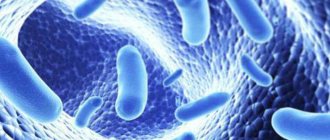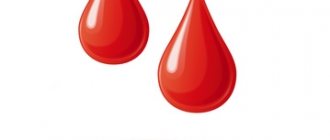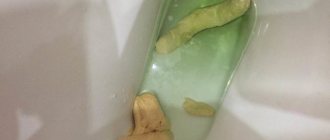Causes of diarrhea
Loose stools appear due to disturbances in the digestive system, and many reasons can contribute to this:
- Viral or bacterial infections.
- Spoiled food containing pathogenic bacteria can cause food poisoning.
- An unbalanced diet, causing a lack of important elements for the body and disruption of metabolic processes and the functioning of internal organs.
- Binge eating.
- Polluted water.
- Nervous shocks, stress, depression.
- Taking certain medications, especially diarrhea, is often caused by antibiotics, which disrupt the balance of microflora and lead to dysbacteriosis.
- Eating plenty of foods containing fiber, sources of which are vegetables and fruits. Fiber increases intestinal contractility, causing diarrhea.
- Poorly washed fruits, vegetables, and herbs can cause intestinal poisoning.
- Allergy.
- Diseases of the digestive system: colitis, gastritis, hepatitis, colitis, etc.
- Chronic diseases.
- Poisoning with toxic substances. These can be poisonous plants or mushrooms, chemicals.
- Climate change.
- Enzyme deficiency, that is, intolerance to certain foods.
- Presence of parasites (worms).
What treatment do doctors prescribe?
If the stool is pale yellow, a strict diet is first introduced for 3-5 days (at the discretion of the doctor). The following foods must be excluded from the diet:
- fatty meat (beef, pork);
- raw vegetables and fruits (boiled and baked - allowed);
- hot, spicy;
- fatty fermented milk products;
- onions, garlic, ginger (even in the form of a tea decoction);
- alcohol, carbonated drinks.
If the doctor prescribes a “fasting day,” this means that you can only drink water and eat only well-cooked rice (in small portions every 2-3 hours).
Also, when prescribing a diet, all food is consumed exclusively in puree form. Even porridge should be ground using a blender or food processor. You should also temporarily stop taking medications that stimulate fluid absorption in the intestines. You should definitely tell your doctor about all medications you take.
Types of diarrhea
Depending on the causes, there are several types of diarrhea:
- neurogenic in nature;
- infectious;
- nutritional diarrhea occurs when you are allergic to foods or have an unbalanced diet;
- toxic diarrhea, the causes of such diarrhea are poisoning with chemical elements;
- dyspeptic diarrhea is called when there is enzyme deficiency of the pancreas, liver, stomach, intestines;
- medicinal, the causes of which are drugs;
- exudative – occurs as a result of diseases of the digestive system.
The nature of the stool depends on the type of diarrhea and the reasons that caused it. This means that loose stools vary in consistency, smell and color, and may contain various impurities such as mucus or blood particles. That is, the color of the diarrhea depends on the root cause.
What is diarrhea?
Diarrhea is a human condition in which frequent bowel movements are observed, while the stool is watery. This condition is dangerous because it can lead to dehydration. Diarrhea can be caused by infections of the digestive tract, poor diet, stress, and drug poisoning.
The disease can also be caused by the presence of worms or intestinal dysbiosis. It is worth carefully monitoring the frequency of stool, paying attention to its smell (sour, putrid), color (gray, white), and the admixture of blood.
There are several types of stool disorders; to determine them, there are specific characteristics that, in fact, distinguish this symptom from the norm.
Clear criteria and differences between them are given in the table:
The data presented in the table requires a little clarification, since the boundaries of normality and pathology are individual for each person. All generally accepted physiological indicators are averaged, combining a fairly wide spread. First of all, it is worth clarifying the indicator of the number of daily bowel movements. For some people it ranges from once every 2-3 days to 3-4 times a day. The same applies to the consistency of feces, which can be from liquid-mushy to solid-formed.
The most important thing when assessing these characteristics of bowel movements is their duration. If they occur over a long period of time (long months and years), without causing any negative manifestations in a person, then there is no need to worry, since such characteristics are individual. This is not diarrhea.
The situation is completely different with other characteristics of the stool, such as odor and the presence of impurities. Their change always indicates diarrhea. Moreover, from time to time, by their appearance, one can clearly determine its origin. Therefore, it is so important to always pay attention to feces, because they indicate the state of digestion and the health of the body as a whole.
Orange loose stools
Often the color of stool depends on what kind of food a person ate. Loose, orange-colored stool may occur from foods containing beta-carotene (vitamin A). Beta-carotene is found in large quantities in berries, vegetables and fruits in orange, red and yellow shades. There is a lot of it in carrots, pumpkin, apricots, melons, plums, nectarines, mangoes, cherries, as well as cauliflower, lettuce, and beet tops. This means that stool can acquire an orange color after eating food containing a huge amount of vitamin A, an overdose of which causes nausea, vomiting, diarrhea, intestinal colic and itching. Orange diarrhea can also be caused by the use of certain medications, such as rifampin.
In addition, orange diarrhea can mean some pathological conditions in the body:
- inflammatory processes in the digestive tract;
- stomach ulcer;
- colitis;
- hormonal disorders;
- pancreatic diseases;
- hepatitis and other liver pathologies;
- diseases of the biliary tract;
- stones in the biliary tract;
- cystitis;
- lung diseases.
Diarrhea from infections, foods and medications
If feeding standards are observed, the causes of diarrhea in children are pathogens of intestinal infections, acute respiratory viral infections, food intolerance, and sensitivity to medications.
Contracting an infection
Kids actively play, explore the world around them, taste and touch everything. And this is fraught with infection. Dirty vegetables and fruits, playing with pets, direct contact with an infected person, and drinking untreated water are the causes of intestinal infection.
Eating disorder
The causes of this type of diarrhea, otherwise called dyspepsia, are overeating sweet, fatty foods, fruits and causes nausea, vomiting, bloating, and greenish loose stools. Often this is also associated with moving to another place of residence, when the diet, diet, and quality of water and food change. In addition, vomiting and rash indicate the presence of an enterovirus infection of the intestine. These symptoms are also characteristic of chickenpox.
Dysbacteriosis
Often the causes of diarrhea are associated with disturbances in the microflora of the gastrointestinal tract, accompanied by loose stools, bloating, gas formation with an unpleasant odor, suspicious color and an abundance of undigested food in the child’s stool.
Food intolerance
This type of diarrhea can be caused by lactase deficiency and gluten intolerance to cereal proteins in children less than 1 year old. To digest breast milk, a special enzyme is required - lactase, which is necessary to break down milk sugar - lactose. If the body of a child under 1 year of age does not produce enough of this enzyme, mother’s milk is not digested, and symptoms of diarrhea appear with profuse foamy diarrhea with a sour odor and rumbling stomach.
The causes of lactase deficiency are related to genetic inheritance, which disappear over time. Diagnosis requires stool samples to be tested for glucose. Gluten intolerance to grain proteins is caused by an allergy called celiac disease. It manifests itself during the transition from breastfeeding to cereals and bread. The cause of the disease is a genetic predisposition to gluten allergies.
Loose brown stools
Normally, the color of human stool varies from brown to dark brown and has a dense consistency. The color of the stool depends on what foods were eaten. Liquid brown stool may indicate a bacterial or parasitic (worm) infection. The waste products of pathogenic organisms irritate the intestinal walls and poison the body, which is why diarrhea occurs. Allergies to food or medications can also cause diarrhea. The shade of diarrhea depends on the diet. The dark color of the feces means that the menu contains more meat products. A lighter brown color appears when there is a predominance of plant or dairy foods. But the most alarming thing is the light brown, almost beige color, which indicates disturbances in the production of liver enzymes or narrowing of the bile ducts.
Treatment
If a person has diarrhea, they may lose a significant amount of fluid through their stool. When this happens, a person may become dehydrated.
A person should drink small sips of water or an electrolyte replacement drink regularly to replenish lost water.
Diarrhea is often the body's way of getting rid of an unwanted virus. Instead of prescribing medications that will slow down bowel movements and cause the body to retain bacteria for longer, doctors may encourage the person to let the diarrhea run its course.
However, prolonged diarrhea may require additional treatments, such as intravenous fluids and medications to reduce intestinal spasms.
In more severe cases of dysentery, a person may be given antibiotics or amoebicidal drugs, or both if the exact cause is unknown.
If a person's red diarrhea is caused by GI bleeding, they may need a blood transfusion until the body can produce more blood. This procedure is performed in a hospital and the patient needs to stay there until the blood test reaches the normal range.
If a person thinks that red diarrhea is caused by medications they are taking, they should talk to their doctor about possible alternatives.
Gray loose stools
Gray stool in an adult may indicate the presence of liver pathologies, such as hepatitis or cirrhosis. Gray diarrhea means that there are disturbances in the bile ducts, which lead to their blockage and disruption of the flow of bile to the intestines, and diseases such as:
- inflammation of the gallbladder (cholecystitis);
- hepatitis;
- Crohn's disease;
- inflammatory diseases of the pancreas, for example, pancreatitis;
- stones or tumors in the gallbladder and bile ducts, liver, pancreas.
In addition, gray liquid stool may have an unpleasant rotten odor caused by:
- disruption of the production of digestive enzymes;
- decreased stomach acidity;
- inflammation of the colon mucosa.
In addition, the formation of gray feces can be affected by an abundance of fatty foods, taking antimicrobial and antifungal drugs, contraceptives, and medications for gout. Allergies can also contribute to the appearance of gray, loose stools.
Causes of red diarrhea
Diarrhea is caused by a virus or bacteria, most often norovirus, antibiotics that destroy bacteria in the stomach. There are several causes of red diarrhea in an adult.
Rotavirus infection
The symptom of rotavirus is red diarrhea, also called stomach flu. It occurs more often in children under 5 years of age, less often in adults. Symptoms of rotavirus:
- Heat
- Vomit
- Abdominal pain
- Diarrhea for 3-7 days
Read more about rotavirus infection.
Gastrointestinal bleeding
In some cases, bleeding in the digestive system can affect the stool. Bleeding in the digestive system can be caused by:
- Constipation
- Intestinal diverticulosis
- Haemorrhoids
- Inflammatory bowel disease
- Intestinal infection
- Stomach ulcer
Blood from the digestive system may be dark in color. The blood from the anus will be bright red.
E. coli infection
The bacterium causes diarrhea and red stool. You can become infected with E. coli from undercooked meat, raw milk, or food that has been treated with animal feces. Symptoms appear several days after infection.
Anal fissures
Inflammation can cause tears around the anus. Tears can add blood to the stool. The redness of the stool will be little noticeable in comparison with other causes of red diarrhea.
Cancer polyps
Excessive bowel movements can irritate the colon and cause polyps to grow. Polyps can be a sign of colorectal cancer. More often the bleeding will be internal, but diarrhea will irritate the polyps and provoke the release of blood into the stool.
Side effects of the medicine
Some medications may cause gastrointestinal bleeding or destroy bacteria in the stomach. This can lead to bleeding or infection, which can cause red diarrhea.
Consuming red food or drinks
Foods or drinks that are red, natural or colored, can cause red stool, such as:
- Wine
- Juices
- Jelly
- Candies
Other reasons
Common factors that can cause red diarrhea:
- Poor hygiene
- Diabetes
- Inflammatory bowel disease
- Eating a lot of meat
- Drinking poor quality water
Loose red stools
Red, loose stools are considered one of the most dangerous, as they may indicate internal bleeding. Often this phenomenon is facilitated by: the destructive process of tumor formations of the digestive organs, inflammation that disrupts the structure of the mucous membrane. Depending on how intensely the stool is colored red, one can assume what pathological condition contributed to this. For example, a dark purple hue of diarrhea suggests that the right half of the large intestine is damaged. Bright red stools are usually the cause of pathologies in the lower intestines. Dark red diarrhea is associated with lesions in the upper parts of the gastrointestinal tract - the esophagus, stomach, and small intestine. A less intense red tint of stool can be expected with hemorrhoids and anal fissures. Also, the red color of stool can be caused by eating tomatoes, beets, medications containing potassium, as well as chemical poisoning and parasitic infections.
So, the red color of liquid stool may mean that there is damage in the digestive tract, accompanied by the release of blood, most often this is facilitated by: ulcerative colitis, Crohn's disease, infectious intestinal pathologies.
Signs of severe diarrhea
When the small intestine is affected, the stool is very liquid (includes undigested food debris) and can be passed up to 6 times a day, causing pain in the lower abdomen, in the navel area.
Signs of severe diarrhea
If the disease affects the large intestine, diarrhea reaches 10 or more times a day, causing abdominal cramps, cutting pain and false urge to defecate.
There are two forms of diarrhea:
- acute (lasting up to two weeks);
- chronic (lasts more than 3 weeks).
Loose bowel movements up to three times a day are considered quite normal. Exceeding this amount indicates severe diarrhea. Then, in addition to a large number of bowel movements, false urges and stool incontinence are added.
The main consequence of prolonged diarrhea is severe dehydration and loss of electrolytes, a condition that can be life-threatening. Therefore, measures against diarrhea must be taken immediately.
Black loose stool
Black color of loose stool means that there is severe damage to the walls of the gastrointestinal tract and the presence of prolonged bleeding. Black diarrhea is characterized by damage to the upper intestines, with loose stools having a tarry consistency and a very unpleasant odor. This type of diarrhea is fraught with a huge threat; it is often accompanied by black or scarlet vomit, which means that the body experiences large blood loss, which leads to a decrease in hemoglobin, pressure, dizziness, loss of consciousness, and coma. The causes of such conditions are ulcers, cancer, gastritis, esophagitis, Crohn's disease, esophageal varices, histoplasmosis.
The formation of dark diarrhea is possible after eating any red food: beets, blueberries, black licorice, prunes. In this case, the consistency of loose stool is not as tarry as with diarrhea caused by bleeding. Also, the appearance of black diarrhea can be caused by:
- excess iron in the body;
- Activated carbon;
- bismuth-based medicines;
- excessive alcohol consumption;
- medications that cause bleeding in the stomach (ibuprofen, aspirin);
- mercury poisoning.
What can the color of baby diarrhea tell you?
The most dangerous thing is diarrhea that occurs in a small child. Here, it doesn’t even matter what color the liquid feces come out. The situation is fraught with the fact that babies develop dehydration very quickly, so in any case it is necessary to see a doctor. You should also save a sample of liquid feces until the doctor arrives. This will help him most accurately determine the cause that caused the appearance of diarrhea of this color and, accordingly, prescribe adequate treatment. In babies, the following shades of feces are distinguished:
- Black or red indicates both the use of beets or activated carbon, and the presence of internal bleeding, so in this case, consulting a doctor is simply necessary;
- The green color of diarrhea, especially with an increase in temperature and mucus in a child, indicates the presence of infectious processes. If such shades of a sharp and unpleasant odor appear in the stool, we can talk about the development of dysentery;
- Discolored feces in a child usually indicate the process of teething, so in the absence of additional pathological signs, parents should not worry. Such diarrhea will end on its own in the near future;
- Repeated yellow diarrhea indicates the presence of a viral infection in the baby’s body. In this case, additional symptoms will be seething and painful sensations in the child’s tummy.
White diarrhea
White diarrhea means bile deficiency. This means that there is a blockage of the bile ducts, which is caused by the following diseases:
- tumors and stones in the bile ducts;
- pancreatitis;
- hepatitis;
- liver cancer;
- cirrhosis;
- Crohn's disease;
- tumor formations of the pancreas;
Often the culprit of pale stools is malignant tumors of the digestive system. You should observe the nature of the regularity of diarrhea. In oncology, it manifests itself in a chronic form, that is, constantly. In other cases, white stools are short-lived.
In addition to organ pathologies, there are other factors that can cause the formation of white, loose stool. This is an unhealthy diet, eating foods that are light in color or contain large amounts of calcium - rice, tapioca, milk, sour cream. Excessive consumption of alcoholic beverages also contributes to the outflow of bile and the appearance of white stool. Another reason may be taking medications for gout, antibiotics, and anti-inflammatory drugs.
What color is diarrhea in a child and an adult?
Diarrhea, a common pathology for many, is characterized not only by stool that is liquid in consistency, but also by the fact that the color of diarrhea in a child or adult very often changes.
In addition, various inclusions may appear in the stool, and they change the smell, which becomes foul. This is because diarrhea itself is not a disease. It is only a sign of some pathology of internal organs. It is these symptoms that tell us what kind of illness caused the patient to develop loose stools, so a very common question asked by a specialist to the patient is what color is the diarrhea and what is its consistency. It is these characteristics of feces that help an experienced clinician determine the origin of the pathology. Both the color of the diarrhea and the inclusions it contains and the frequency of bowel movements are of great importance in determining the cause of the disease. Many people are interested in the question: what can be found out by the color of feces and the number of bowel movements per day? Experts recommend paying attention to the following signs:
- The most favorable and prosperous is yellow diarrhea. Its appearance is due to increased intestinal motility. But, despite the fact that contractions of the walls of the digestive organ become very frequent and feces quickly move through it without having time to form, yellow diarrhea is not characterized by the presence of any pathological signs. Typically, with such diarrhea, the patient has a slight heaviness and pain in the abdomen. What reasons can provoke the appearance of yellow liquid stools? It usually occurs when taking certain medications, viral hepatitis, or the presence of any infection in the body;
- If an adult has a history of diseases of the liver, gallbladder or pancreas, his diarrhea will be white and contain undigested food debris. When the absence of any shades in feces is observed in a child in the first year of life, such bowel movements are provoked by the use of certain mixtures or the transition to a new type of complementary feeding. The white color of baby diarrhea can also appear during teething. If the frequency of bowel movements is low or occurs periodically, the pathology should not cause any particular concern. But in the case when white feces acquire a watery consistency and bowel movements become more frequent than 5 times a day, immediate consultation with a doctor is required, since the white color of diarrhea becomes an indicator of illness;
- The appearance of green tints in the stool of an adult is a sign of bacterial infection or fermentation. Such bowel movements are always accompanied by the presence of mucus, blood streaks and a foul odor. The safest reason for stool to acquire such shades is the large amount of greens consumed in food;
- Tarry, brown-black diarrhea in an adult is the main sign that bleeding has begun in the upper gastrointestinal tract. In children, it usually indicates that activated carbon was taken;
- Bright red stool indicates bleeding that began in the distal gastrointestinal tract. This is the most threatening type of diarrhea, therefore, if stool has any shades of red (from light pink to cherry color), urgent hospitalization is necessary.
Green diarrhea
Green color of loose stool indicates intestinal infections. These diseases are characterized by disruption of the intestinal microflora as a result of the suppression of beneficial microbes in the intestine by pathogenic ones, the growth of which causes fermentation. They are accompanied by a sour, putrid odor and the presence of mucus in the stool. The causes of green feces are: violation of hygiene standards, treatment with antibiotics, consumption of spoiled food, unwashed vegetables and fruits. Feces can also acquire a green color after eating lettuce, spinach, sorrel, that is, greens.
Green stool may also indicate problems with the liver and blood.
Diarrhea Treatment Methods
The main rule in treating diarrhea is to drink plenty of fluids.
Frequent bowel movements dehydrate the body, so fluid should be replenished regularly, every half hour. But you should not use carbonated drinks or raw water. It is best to drink herbal infusions, decoctions and jelly, which have astringent, anti-inflammatory and antimicrobial effects. The following are suitable for this: St. John's wort, rose hips, chamomile, blueberries, bird cherry, apples, pears, lingonberries, etc. To remove toxins from the body, you should take drugs that have adsorbing properties - carbon tablets, Smecta, Enterosgel. Salt solutions, for example, Regidron, help replenish the water balance. Until it is known what causes the diarrhea, you should not take drugs to consolidate the stool. First you need to undergo an examination. You should also consult a doctor if diarrhea does not go away for more than a day, is accompanied by abdominal pain, fever, or impurities in the form of blood and mucus in the stool.
In case of stool disorders, it is necessary to adhere to dietary nutrition. In the first hours after the appearance of unpleasant symptoms, or better yet for a day, it is better to refuse food, using only drink. The diet should contain food that helps restore the digestive tract. If vomiting is present, a decoction of rice is suitable. You can eat:
- rice or oatmeal;
- crackers;
- soft-boiled eggs;
- boiled meat or fish (but low-fat varieties);
- low-fat cottage cheese, yogurt, kefir;
- boiled vegetables;
- baked apples;
- bananas.
It is important that the food is pureed. You should avoid fatty, spicy, smoked, cold and hot foods so as not to irritate the intestines.
https://youtu.be/sjVLKPYF7vE
Why might a child have gray diarrhea?
With diarrhea, few adults immediately rush to see a doctor. But it is simply necessary to visit the hospital if the child has diarrhea and in addition the color of the stool has changed. Dark brown or gray diarrhea should alert parents, since this phenomenon is not considered normal and almost always indicates serious pathologies . In this case, it is very important to consult a doctor as quickly as possible, since for some diseases the success of treatment depends on the timely administration of therapy.











